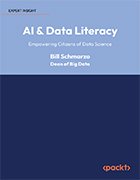
Blue Planet Studio - stock.adobe
How to measure data literacy in the AI era
Improving data literacy as an individual or organization starts with measuring where you are. An AI and data framework provides six criteria to track progress.
AI and data use is too widespread for a small number of specialists to handle on their own. Every member of an organization is responsible for safe, productive data use in workflows and decision-making. They need some level of data literacy to make that happen.
Data literacy is a person's ability to derive meaning from the information collected from internal or external sources. Data scientists and analysts are the most fluent in this area. Less technically skilled users should understand the data they're looking at and how to use it effectively. Everyone should understand data governance policies to properly secure and protect company data.
Bill Schmarzo opens his book, AI & Data Literacy: Empowering Citizens of Data Science, with an emphasis on why every person needs AI and data literacy education.
"We must prepare everyone to become Citizens of Data Science and to understand where and how AI can transform our personal and professional lives by reinventing industries, companies, and societal practices to fuel a higher quality of living for everyone," Schmarzo wrote.
One of the most difficult aspects of data literacy is measuring your current level and which skills need improvement. Schmarzo engages readers to actively evaluate themselves using six criteria as they read the book.
He created the AI and Data Literacy Framework. It contains the six components citizen data scientists need to succeed:
- Data and privacy awareness.
- AI and analytic techniques.
- Making informed decisions.
- Prediction and statistics.
- Value engineering competency.
- Ethics.
Each category has key concepts everyone needs to responsibly and ethically use data and AI. Schmarzo provides a table in Chapter 1, shown here, to help you measure your data literacy levels.
| Category | Low | Medium | High |
| Data & Privacy Awareness | Just click and accept the website and mobile app's terms and conditions without reading | Attempt to determine the credibility of the site or app before accepting the terms and downloading | Read website and mobile app privacy terms and conditions and validate app and site credibility before engaging |
| Informed Decision-making | Depend on their favorite TV channel, celebrities, or website to tell them what to think; prone to conspiracy theories | Research issues before making a decision, though still overweigh the opinions of people who "think like me" | Create a model that considers false positives and false negatives before making a decision; practice critical thinking |
| AI & Analytic Techniques | Believe that AI is something only applicable to large organizations and three-letter government agencies | Understand how AI is part of a spectrum of analytics, but not sure what each analytic technique can do | Understand how to collaborate to identify KPIs and metrics across a wide variety of value dimensions that comprise the AI utility function |
| Predictions & Statistics | Don't seek to understand the probabilities of events happening; blind to unintended consequences of decisions | Do consider probabilities when making decisions but carry out a thorough assessment of the potential unintended consequences | Actively seek out information from credible sources to improve the odds of making an informed decision |
| Value Creation | Don't understand the dimensions of "value" | Understand the value dimensions but haven't identified the KPIs and metrics against which value creation effectiveness is measured | Understand the value dimensions and have identified the KPIs and metrics against which value creation effectiveness is measured |
| Ethics | Think Ethics is something that only applies to "others" | Acknowledge the importance of ethics but not sure how best to address | Proactively contemplate different perspectives to ensure ethical decisions and actions |
Data literacy is not just an individual endeavor. Organizations should take the initiative to evaluate literacy levels top to bottom, identify what needs to change and provide resources to help their employees get the training they need.
Check out the excerpt from Chapter 1 of AI & Data Literacy: Empowering Citizens of Data Science to learn more about assessing AI and data literacy, its importance and its challenges. Visit the Packt Publishing press page to learn more about the book.
Editor's note: TechTarget editors thank author Bill Schmarzo for his insights on the topic and contributions to this coverage.
Peter Spotts is the site editor for SearchBusinessAnalytics and SearchDataManagement, writing and managing content on both sites. Prior to joining TechTarget in July 2021, Peter worked for Turley Publications in Palmer, Mass., as both a staff writer and editor covering local events and news for six years in Western Massachusetts.








